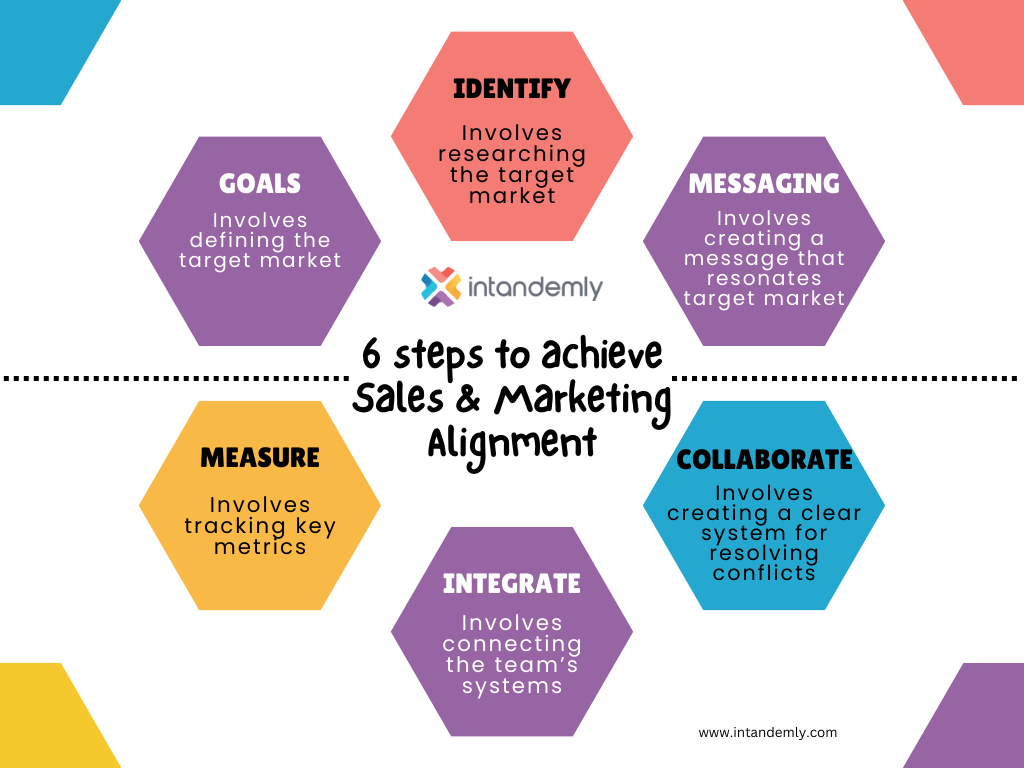Achieving Alignment: 6 Simple Steps for Sales & Marketing Teamwork
Introduction
When sales and marketing teams are in perfect alignment, it can be a powerful force that drives growth, accelerates customer acquisition and drives customer success. Unfortunately, achieving alignment between sales and marketing teams can be a daunting task.
It requires hard work and dedication, but the rewards are well worth the effort. With the right strategies and processes in place, sales and marketing teams can work together to create a powerful, unified force.
Here are 6 simple steps that any team can use to create alignment and ensure that both sales and marketing teams are working together towards common goals. These steps will help teams create an environment of collaboration and trust that will enable them to work more efficiently and effectively.

Image Source: FreePik
Step 1: Setting Clear Goals and Objectives
The first step to achieving alignment between sales and marketing teams is to set clear goals and objectives. This involves defining the target market, creating measurable goals, and setting timelines for reaching those goals.
It is important to ensure that everyone on the team is on the same page and understands their role in reaching the team’s objectives. Additionally, it is important to ensure that everyone understands the importance of their individual contributions and how they will contribute to the overall success of the team.
Once the goals and objectives are established, it is important to create a plan of action that outlines how the team will reach those goals. This plan should include a timeline with milestones, as well as specific tasks that need to be completed in order to reach the objectives.
This plan should also include ways to measure progress and success, so that everyone can track the team’s progress and make adjustments if necessary.
Step 2: Identifying Your Target Audience
The second step in achieving alignment between sales and marketing teams is to identify the target audience. This involves researching the target market and understanding their needs, preferences, and behaviors.
The team should use this information to create buyer personas, which will help them better understand their target market and tailor their campaigns and messaging to meet their needs. Additionally, the team should identify key influencers within the target market and create a strategy for engaging with them.
Once the target audience is identified, the team should create a buyer journey map to understand the different stages of the customer’s journey and create content that is tailored to each stage.
This will help the team create more effective campaigns and messaging that resonates with the target audience. Additionally, the team should create a customer experience roadmap that outlines how customers will interact with the brand throughout their journey.
This roadmap should include touchpoints, such as website visits, emails, and phone calls, as well as strategies for engaging with customers at each touchpoint.
Step 3: Creating a Unified Messaging Strategy
The third step in achieving alignment between sales and marketing teams is to create a unified messaging strategy. This involves creating a consistent message that resonates with the target audience and is tailored to each stage of the buyer’s journey.
The message should be clear and concise, and should include calls to action that encourage the customer to take the desired action. Additionally, the message should be tailored to each platform that the team is using to reach the target audience.
It is also important to establish a consistent voice for the team’s messaging. This voice should be consistent across all platforms and should reflect the brand’s values and culture.
The team should also create a style guide that outlines the team’s messaging standards, such as tone, word choice, writing style, and formatting. This will help ensure that the team’s messages are consistent and unified.
Step 4: Establishing a Process for Communication and Collaboration
The fourth step in achieving alignment between sales and marketing teams is to establish a process for communication and collaboration. This involves creating a clear system for communicating information, providing feedback, and resolving conflicts.
The team should identify a central point of communication, such as a shared document or platform, where information can be shared and discussed. Additionally, the team should create a feedback system that allows team members to provide constructive feedback in a respectful and professional manner.
It is also important to create a clear process for resolving conflicts. This could include a system for mediating disagreements or a process for escalating issues to senior team members.
Additionally, the team should create a culture of collaboration, where team members are encouraged to work together to find innovative solutions to problems. This will help create an environment of trust and respect, which will enable the team to work together more effectively.
Step 5: Integrating Sales and Marketing Systems
The fifth step in achieving alignment between sales and marketing teams is to integrate the team’s sales and marketing systems. This involves connecting the team’s systems, such as CRM, marketing automation, and analytics, to ensure that data is shared across the team.
This will enable the team to have a better understanding of their target audience and create more effective campaigns. Additionally, the team should create a system for tracking customer interactions and activities, such as website visits, emails, and phone calls, so that the team can better understand the customer’s journey.
It is also important to create a system for tracking performance and progress. This could include creating dashboards and reports that track key metrics, such as lead generation, customer acquisition, and customer retention.
This will enable the team to track their progress and make adjustments if necessary. Additionally, the team should put in place a system for tracking revenue and ROI, so that the team can measure the effectiveness of their campaigns and strategies.
Step 6: Measuring Results and Taking Action
The sixth step in achieving alignment between sales and marketing teams is to measure the results and take action. This involves tracking key metrics, such as website visits, lead generation, and customer acquisition, and analyzing the data to identify areas for improvement.
Additionally, the team should track revenue and ROI to measure the success of their campaigns. Once the team has identified areas for improvement, they should take action to make changes and optimize their strategies.
It is also important to track customer satisfaction and loyalty, as this can be an indication of how successful the team’s efforts are. The team should track customer feedback and engagement, as well as customer retention rates, to ensure that the team is meeting the customer’s needs.
Additionally, the team should track the effectiveness of their campaigns, such as email open and click-through rates, to ensure that the team is creating relevant and engaging content that resonates with the customer.
Benefits of Sales and Marketing Alignment
When sales and marketing teams are in perfect alignment, it can be a powerful force that drives growth, accelerates customer acquisition, and drives customer success. Achieving alignment between sales and marketing teams will enable the team to create a unified messaging strategy that resonates with the target audience and is tailored to each stage of the customer’s journey.
Additionally, the team will be able to create more effective campaigns and strategies that are tailored to the customer’s needs.
Alignment between sales and marketing teams will also enable the team to work more efficiently and effectively. When all team members are working towards the same goals and are in sync, it will enable them to work together more efficiently and achieve better results. Additionally, the team will be able to track performance and progress more effectively, as they will be able to measure the success of their campaigns and strategies.
Common Challenges and How to Overcome Them
When it comes to achieving alignment between sales and marketing teams, there are a few common challenges that teams face. One of the most common challenges is communicating and collaborating effectively.
This can be difficult, especially when team members are working remotely or in different locations. To overcome this challenge, the team should create a clear system for communication and collaboration, such as a shared document or platform, so that all team members are on the same page.
Another common challenge is creating a unified messaging strategy. This can be difficult, as it involves creating a consistent message that resonates with the target audience and is tailored to each stage of the customer’s journey.
To overcome this challenge, the team should create a style guide that outlines the team’s messaging standards, such as tone, word choice, writing style, and formatting. Additionally, they should establish a consistent voice that reflects the brand’s values and culture.
A final common challenge is measuring results and taking action. This can be difficult, as it requires the team to track key metrics and analyze the data to identify areas for improvement. To overcome this challenge, the team should create a system for tracking performance and progress, such as dashboards and reports, as well as systems for tracking revenue and ROI.
Additionally, the team should track customer feedback and engagement, as well as customer retention rates, to ensure that the team is meeting the customer’s needs.
Tips for Achieving and Maintaining Alignment
Achieving alignment between sales and marketing teams can be a daunting task, but it is well worth the effort. To ensure that the team is able to achieve and maintain alignment, there are a few tips to keep in mind.
- Set clear goals and objectives:
This involves defining the target market, creating measurable goals, and setting timelines for reaching those goals. It is also important to create a plan of action that outlines how the team will reach those goals. This plan should include a timeline with milestones, as well as specific tasks that need to be completed in order to reach the objectives.
- Identify the target audience:
This involves researching the target market and understanding their needs, preferences, and behaviors. The team should use this information to create buyer personas and create a buyer journey map that outlines the different stages of the customer’s journey.
- Create a unified messaging strategy:
This involves creating a consistent message that resonates with the target audience and is tailored to each stage of the buyer’s journey. Additionally, the team should create a style guide that outlines the team’s messaging standards and establish a consistent voice that reflects the brand’s values and culture.
- Establish a process for communication and collaboration:
This involves creating a clear system for communicating information, providing feedback, and resolving conflicts. Additionally, the team should create a culture of collaboration, where team members are encouraged to work together to find innovative solutions to problems.
- Integrate the team’s sales and marketing systems:
This involves connecting the team’s systems, such as CRM, marketing automation, and analytics, to ensure that data is shared across the team. Additionally, the team should create a system for tracking customer interactions and activities, as well as a system for tracking performance and progress.
- Measure the results and take action:
This involves tracking key metrics, such as website visits, lead generation, and customer acquisition, and analyzing the data to identify areas for improvement. Additionally, the team should track revenue and ROI to measure the success of their campaigns. Once the team has identified areas for improvement, they should take action to make changes and optimize their strategies.

Conclusion
Achieving alignment between sales and marketing teams can be a difficult task, but it is well worth the effort. With the right strategies and processes in place, sales and marketing teams can work together to create a powerful, unified force.
By following the 6 simple steps outlined in this article, teams can create an environment of collaboration and trust that will enable them to work more efficiently and effectively. With the right strategies and processes in place, teams can create an environment of collaboration and trust that will enable them to reach their goals and drive customer success.






![Content Marketing Trends-2024 [Comprehensive Guide]](https://www.intandemly.com/wp-content/uploads/2016/07/content-marketing-blog-banner-50x50.png)

